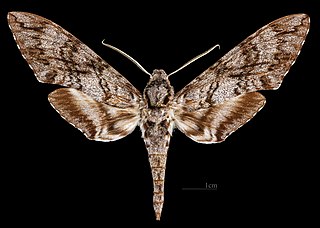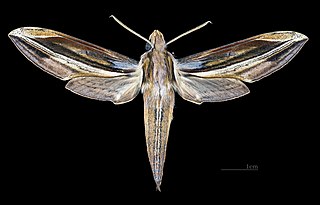
Eumorpha capronnieri is a moth of the family Sphingidae first described by Jean Baptiste Boisduval in 1875.

Eumorpha elisa is a moth of the family Sphingidae.

Eumorpha phorbas is a moth of the family Sphingidae.

Eumorpha triangulum is a moth of the family Sphingidae.

Eumorpha vitis, known as the vine sphinx, is a moth of the family Sphingidae.

Manduca corumbensis is a moth of the family Sphingidae.

Xylophanes dolius is a moth of the family Sphingidae. It is known from Ecuador and Bolivia.

Xylophanes pyrrhus is a moth of the family Sphingidae.

Xylophanes rothschildi is a moth of the family Sphingidae. It is found from Colombia, Ecuador and Peru south to Bolivia.

Oryba achemenides is a moth of the family Sphingidae.

Eumorpha adamsi is a species of moth in the family Sphingidae. It was described by Walter Rothschild and Karl Jordan, in 1903, and is known from Venezuela, Brazil, Bolivia and Paraguay but is probably present throughout most of South America.

Isognathus leachii is a moth of the family Sphingidae.

Eumorpha analis is a moth of the family Sphingidae.

Eumorpha drucei is a moth of the family Sphingidae. It is known from Ecuador.

Eumorpha obliquus is a moth of the family Sphingidae. It is found from Belize, Guatemala, Nicaragua and Costa Rica south to Bolivia. It is also present in Brazil and Guadeloupe.

Eumorpha translineatus is a moth of the family Sphingidae.

Eumorpha megaeacus is a moth of the family Sphingidae.

Eumorpha neuburgeri is a moth of the family Sphingidae. It is known from Argentina and Bolivia.

Eumorpha strenua is a moth of the family Sphingidae. It is known from Haiti, Cuba and the Dominican Republic.

Manduca trimacula is a moth of the family Sphingidae. It is found from Colombia to Ecuador, Venezuela and Bolivia.























